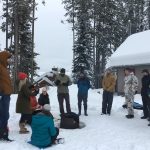Advancing CBSM in the Basin!

The Community-Based Social Marketing Advanced Workshop with Doug MacKenzie-Mohr reinforced our knowledge and understanding of CBSM and provided opportunities to think through the application of tools, designing evaluating programs, and presenting the topic to others. The workshop was structured around small theme-based groups that used an agreed-to sustainability topic – i.e. streambank restoration, organic diversion, anti-idling etc. – to focus discussion during multiple group exercises.
The exercises and presentations were structured around the five CBSM steps:
- behaviour selection,
- barrier and benefit research,
- strategy development,
- pilot testing and
- implementing and monitoring
Presenter and host Doug Mackenize Mohr generously shared many ideas and examples. These are just a few that stuck out for us and may offer practical insights to others:
- Do a detailed behaviour chain. This will help you identify the specific “steps” that may contribute to a single action. For example, if your goal is to change behaviour to get a target population to ride their bikes to work, that action includes several smaller steps: getting a bike that works, getting gear, adjusting your routine so you can ride your bike, parking and locking your bike etc. Your CBSM work should focus on a non-divisible end state behaviour within that behaviour chain.
- What’s an end-state behaviour? That’s the behaviour that matters (i.e. the homeowner installs the low-flow shower head). Focus on a positive behaviour change; focus on pride not shame. If you can observe someone doing it, it’s a behaviour
- Consider the context for your target population and the behaviour you want to change. CBSM strategies need to reflect the target population.
- Barriers could be “fake news” – Doing research to confirm possible barriers (and benefits) to your desired behaviour change is key. Without this knowledge practitioners would be guessing and may be wrong about what will motivate the target population to change their behaviour or resist a change. When wheeled garbage bins were introduced in Atlantic Canada, there was a perception that they would be too heavy to use. That assumption was pre-emptively negated by by an elderly woman who was featured in ads demonstrating how easy it was to manage the bin.
- Use visuals to tell your story. When planning your strategy, look for ways to use clear visuals as part of your effective communications strategy. Think about communications to help the target population identify plant or fish species and the role visuals would play.
- Be sure your barrier and benefit research is representative of your target audience. Be sure you don’t deliver your pilot program to the same group that participated in the research, they will have been influenced by participating in the research.
- Basic Barrier and benefit research Qs:
- What is hard about doing (the behaviour you want people to do)?
- What are the benefits of doing (the behaviour you want people to do)?
- Basic probability and penetration research Qs:
- Are you presently doing (the behaviour you want people to do)?
- What’s the likelihood you would do (the behaviour you want people to do)?
- Harness the power of groups like colleagues and neighbours to help catalyze behaviour change. Think about public commitments in an office or lawn signs to help create social norms.
- Pilot more than one behaviour change at a time to assess the return on investment. Some behaviour change strategies may offer lower rate of change +/- at a lower cost than others. See Doug’s ROI formula.
We have also been provided with an Executive presentation that we can utilize to present the CBSM concept to organizations in the Columbia Basin.




